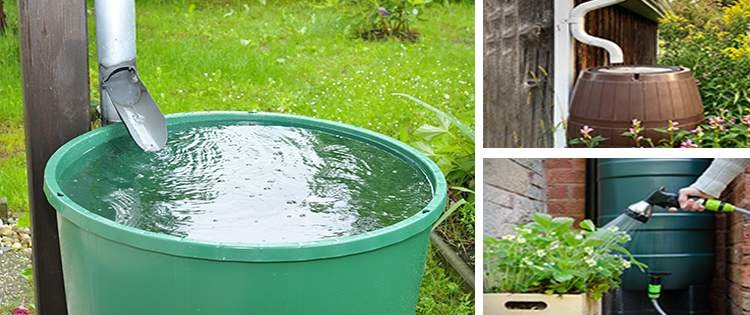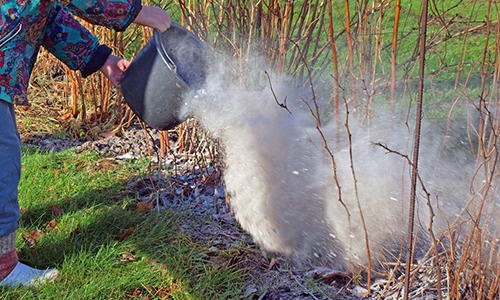Passionfruit is a tasty and exotic fruit that is popular all over the world. Its distinct flavor, acidic scent, and versatility in culinary creations make it a favorite option among both foodies and gardeners. Growing passionfruit at home is not only a pleasant and rewarding pastime, but it also ensures that you always have access to fresh and healthy fruit.
With the correct equipment, techniques, and a little patience, you can easily grow passionfruit at home, whether you have a little balcony or a vast garden. This tutorial will teach you all you need to know to successfully produce passionfruit at home. We’ll go through everything from picking the correct kind to planting, fertilizing, and harvesting. Lets begin.
A Brief History
Passionfruit, native to South America, has been cultivated for centuries for its delicious fruit and fragrant flowers. It is thought to have been introduced to Europe through the Spanish conquistadors.
In the late 18th century, passionfruit was brought to the West Indies by missionaries who had encountered it in South America. From there it was taken to Hawaii and other tropical regions, where it quickly became popular due to its sweet flavor and abundance of health benefits.
Today, passionfruit is grown in many parts of the world and is a popular ingredient in desserts, beverages, sauces, and salads.
The passionfruit plant is a woody vine that grows best in warm climates with plenty of sunlight and well-drained soil. It can reach up to six meters in one year under optimal conditions and produces fragrant flowers followed by yellow, orange or purple-black fruits. The fruits contain an edible pulp full of healthy vitamins and minerals as well as hundreds of small edible seeds.
Passionfruit can be used in a variety of ways including juicing or making jam, ice cream or sorbet. Its sweet flavor also makes it a great addition to salads and smoothies or as a topping for desserts. The fruit’s fragrant flowers can also be used as decorations for cakes or other pastries.
Whether you are looking for a delicious treat or an attractive addition to your garden, growing passionfruit at home is an enjoyable experience that will bring you plenty of health benefits!
Nutritional Benefits
Passion fruit is highly nutritious, providing a range of vitamins and minerals that are essential for healthy body function. It contains 17 calories per serving, 2 grams of dietary fiber, 9% of the Daily Value (DV) of Vitamin C, 8% of the DV of Vitamin A and 2% of the DV of Iron.
Here are some of the key nutritional benefits of passionfruit:
High in Vitamin C: Passionfruit is an excellent source of vitamin C, which is essential for boosting your immune system, promoting skin health, and reducing inflammation.
Rich in Fiber: Passionfruit is a good source of dietary fiber, which can help regulate digestion, promote satiety, and reduce the risk of chronic diseases like heart disease, diabetes, and cancer.
Contains Antioxidants: Passionfruit is rich in antioxidants like vitamin A, beta-carotene, and flavonoids, which can help protect your body against free radicals and oxidative stress, reducing the risk of chronic diseases.
Low in Calories: Passionfruit is low in calories and high in water content, making it an excellent fruit choice for those trying to lose weight or maintain a healthy weight.
Contains Essential Minerals: Passionfruit is a good source of essential minerals like potassium, iron, and copper, which can help maintain healthy blood pressure, promote red blood cell formation, and support nerve and muscle function.
In general, passionfruit is a nutritious and healthy fruit that can provide numerous health benefits. Incorporating passionfruit into your diet can help improve your overall health and well-being, making it an excellent addition to your home garden.
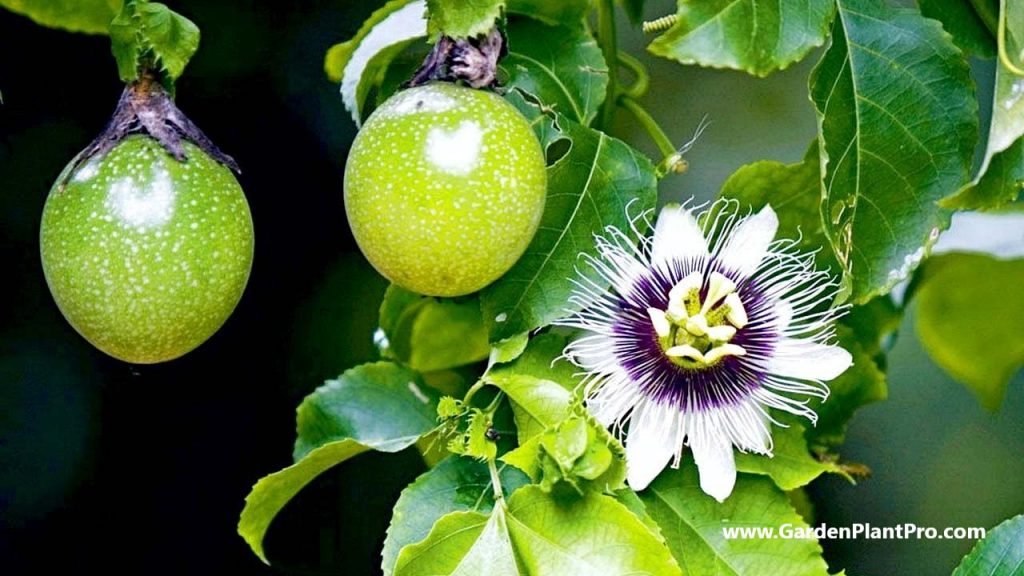
Common Varieties & Their Uses
Passionfruit comes in many varieties, each with its own unique flavor and uses. The most popular varieties are the purple or black-skinned passionfruit, yellow or golden passionfruit, and the sweet granadilla.
The purple or black-skinned passionfruit is most common in Australia and New Zealand and has a tart flavor with a sweet aftertaste. It can be eaten fresh, used in jams and jellies, or added to drinks and desserts.
The yellow or golden passionfruit has a sweet, tropical flavor and is commonly used to make juices, syrups and cocktails. It can also be used in sweet recipes such as cakes, ice cream and mousses.
The sweet granadilla is native to South America and has a very distinct flavor that is much sweeter than other varieties. Granadilla can be used in both sweet and savory dishes, as well as drinks such as caipirinha.
DIY PROJECT: Collect rainwater no matter where you live...
This DIY project is the best way to legally collect rainwater NO MATTER where you live. Get chlorine-free water, cut down on your water bills, and have enough for an emergency situation or to water your garden. Read More Here...
No matter which variety of passionfruit you choose for your garden, make sure to select one that is suited to your climate and soil type for best results.
When planting passionfruit vines, it’s important to choose a sunny spot that’s sheltered from wind and frost. Passionfruit loves well-drained soil with plenty of compost-rich material such as rotted manure or composted leaves. To encourage healthy growth and maximum fruit production, fertilize the vine every six weeks during the growing season with a general fertilizer high in nitrogen, phosphorus and potassium.
When To Sow Or Plant
When it comes to sowing or planting passionfruit, it’s best to wait until the spring when all risk of frost has passed. It is recommended to prepare the soil before planting. Dig through plenty of compost, adding some sand to improve drainage and mix in some organic fertilizer. Passionfruit vines require well-drained soil and plenty of sunlight, so choose a sunny spot with a nutrient-rich soil.
To sow your passionfruit seeds, plant them in small containers filled with potting mix. Keep them in a warm and humid environment and make sure they are watered regularly.
If you are planting seedlings or cuttings, wait until they are about 8 inches high (20 cm) before transferring them into the prepared hole in the garden. Water them in well and continue to water regularly during the warmer months. Passionfruit plants should bear fruit about 18 months after planting and will start to flower after this time.
Choose The Right Location
Choose the right location for your passionfruit plant is essential to ensure it grows and produces the best crops. Passionfruit are frost tender, so they need to be planted in a sunny, sheltered spot with free draining soil. Choose a warm, sunny location that is sheltered from strong winds and frost.
In colder climates, choose a spot in front of a north-facing wall for extra protection. Dig through plenty of compost and add some sand to improve drainage. Plant in spring for the best results. It’s also important to provide your passionfruit vine with enough support. Good support structures include a fence, trellis or an arbor. Once you’ve chosen the right location, you’re ready to prepare the soil for planting.
Preparing the soil for growing passionfruit is essential for successful planting. To ensure the best results, it is important to dig through plenty of compost and add some sand to improve drainage.
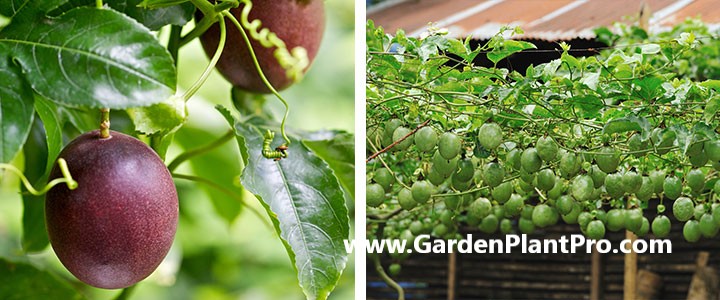
Prepare The Soil
It is important to provide the plant with nutrient-rich, well-draining soil to ensure healthy growth and a bountiful harvest. Here are the steps to prepare the soil for growing passionfruit:
Choose the Right Location: Passionfruit thrives in well-draining soil with a pH level of 6.0-6.5. Choose a location that receives full sun or partial shade, depending on your climate. Make sure the area is sheltered from strong winds, as passionfruit vines can be susceptible to damage.
Clear the Area: Clear the area of any weeds, rocks, or debris. Remove any grass or vegetation within a radius of 1 meter (3 feet) from where you plan to plant the passionfruit. This will help prevent competition for nutrients and water.
Dig the Hole: Dig a hole that is twice the width of the pot and the same depth as the root ball. Add organic matter to the bottom of the hole, such as compost, aged manure, or peat moss, to help improve soil fertility and drainage.
Mix in Fertilizer: Mix a slow-release fertilizer into the soil, such as a balanced NPK fertilizer, according to the manufacturer’s instructions. This will help provide the plant with essential nutrients throughout the growing season.
Plant the Passionfruit: Carefully remove the passionfruit plant from its pot and place it in the hole, ensuring the top of the root ball is level with the soil surface. Backfill the hole with soil, gently firming it around the plant.
Water the Plant: Water the plant thoroughly after planting to help settle the soil and provide the plant with the moisture it needs to establish its roots.
Plant The Seeds, Seedlings Or Cuttings
When starting from seed, make sure to use fresh passionfruit seeds, as older ones can take longer to germinate. Place the seeds in a small (10cm) pot filled with seed-raising mix, and water generously. If you are planting a seedling or cutting, then make sure the soil is light and sandy loam, with a pH of 6.5-7.5.
For best results when growing passionfruit from seed, start indoors in a sterile seed-starting mix and soak the seeds overnight before sowing. This will help to speed up germination. Once planted, keep the soil moist but never too wet or dry.
Do you have some charcoal in your house right now? We call charcoal a “miracle leftover” for anyone who wants to be a little more self-sufficient and cut costs. That’s because it can help you with so many different things around the house and garden. You can even use it to make an energy-free fridge. Read More Here...
When planting either from seedlings or cuttings, ensure that the vine is planted in an area with full sun exposure, except for in very hot areas where partial shade may be more suitable. Water regularly but not excessively to avoid drowning the plant.
When planting grafted varieties of passionfruit plants, ensure that the variety your plant is grafted onto is suitable for your climate and conditions. Grafted varieties tend to be more robust and reliable than those grown from seed but may not always be suitable for your location or requirements.
Take care to also check for any pests or diseases that may be present when planting and take appropriate measures if needed. Once planted and established, it’s important to provide regular maintenance such as pruning and fertilizing to ensure healthy growth and optimal fruit production.
With some care and attention, a vine grown from seed should produce fruit within 18-24 months.
Watering & Fertilizing
Once you have chosen the right location and prepared the soil for planting, it’s time to start watering and fertilizing your passionfruit plants.
Watering is essential for keeping passionfruit healthy and vigorous. It should be done at least once a week and more often during hot or dry weather. The best way to water is to use a soaker hose or drip irrigation system, as this will ensure that the roots are getting the water they need without wasting any.
It’s also important to fertilize your passionfruit plants on a regular basis. A balanced fertilizer that contains nitrogen, phosphorus and potassium is best. You can either use a liquid fertilizer or apply a slow-release granular fertilizer around the base of the plant. Be sure to follow the instructions on the package for application rates and timing.
Organic mulch can also help with water retention and reduce weeds around your passionfruit plants. Add a 2-4 inch layer of mulch around each plant, making sure not to cover up any stems or leaves. Mulch should be reapplied each season or when it starts to break down.
Finally, it’s important to monitor your passionfruit plants for signs of overwatering or underwatering. If you notice that the leaves are wilting or turning yellow, it’s likely due to insufficient watering. On the other hand, if you see yellowing leaves with brown edges, this could be due to overwatering. Adjust your watering schedule accordingly and make sure your soil is well-drained so that excess water can drain away from the roots of your plants.
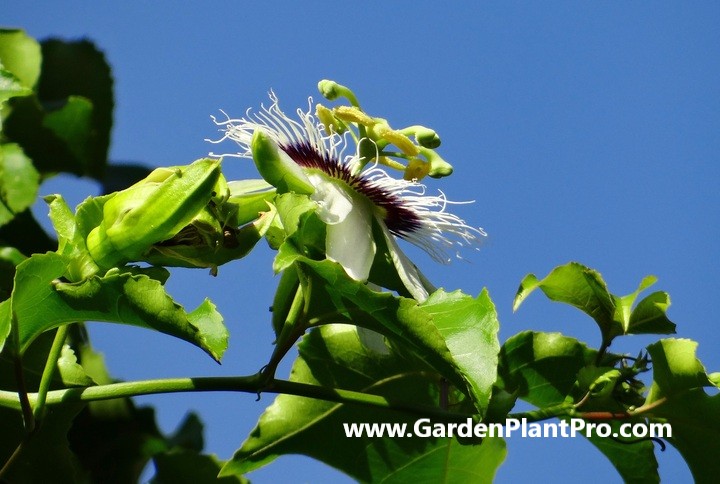
Maintenance & Training The Vines
Maintaining your passionfruit vine is relatively easy and low-maintenance, provided it is getting what it needs in terms of water, nutrients and sunlight.
The vine will need to be watered regularly, especially during the dry season. Water the soil near the plant, not the plant itself, and avoid wetting the foliage.
Fertilizer should be applied a few times a year to ensure that your vine is getting all of the essential nutrients it needs for healthy growth and fruiting.
Pruning may also be necessary to keep the vine under control or to remove overgrown growth. Pruning should be done in early spring before any new growth appears. It’s best to prune only a few branches at a time so as not to shock the plant.
Training the vine is an important step in growing passionfruit, as it helps to support the plant and encourage healthy growth. Here are some tips for training your passionfruit vine:
Provide support: Passionfruit vines are climbers and need support to grow properly. You can provide support by installing a trellis or sturdy fence for the plant to climb on.
Choose a leader: Choose one main stem to be the leader and remove any competing stems that may develop. The leader should be tied to the support structure and encouraged to grow upwards.
Prune regularly: Regular pruning is important to prevent the plant from becoming too bushy and to encourage fruiting. Prune any side shoots that develop off the main stem and remove any dead or diseased wood.
CASE STUDY: We've been living off the grid for the last 40 years...
In all that time an electric wire has never been connected to our house. We haven’t gotten or paid an electricity bill in over 40 years, but we have all the electricity we want. We grow everything we need, here, in our small backyard. We also have a small medicinal garden for tough times. Read More Here...
Train the vine: As the plant grows, train it to follow the support structure by tying it to the trellis or fence. You can use soft twine or plant ties to tie the vine to the support structure.
Pinch off new growth: Pinch off the growing tips of the vine when it reaches the top of the support structure. This will encourage lateral growth and help to produce more fruit.
Remove old wood: After the plant has finished fruiting, remove any old wood to promote new growth and ensure the plant remains healthy.
By following these tips for training your passionfruit vine, you can help to promote healthy growth, prevent disease, and ensure a bountiful harvest of delicious fruit.
When & How To Harvest
When it comes to harvesting passionfruit, timing is everything. In general, you should harvest the fruit when it begins to soften, usually mid summer-autumn. To ensure the highest quality fruit, monitor the condition of the fruit closely and pick it when it’s ripe.
To harvest the fruit, simply cut or twist off the stem.
If the stem doesn’t come away easily, let the fruit remain on the vine a bit longer. The stem will provide protection from pests and ensure that the fruit will ripen properly.
If you’re growing passionfruit in containers, or have been training the vines more vertically, you may need to use a ladder to reach the fruit. Be sure to use a sturdy ladder and take all necessary precautions to avoid injury.
Once you’ve harvested your passionfruit, store it in a cool location for up to two weeks. If you want to store it longer, place the unripe fruit in a sealed container at room temperature until it ripens.
Storing & Preserving
Storing and preserving your passionfruit harvest is a great way to make the most of your crop! Passionfruit can be stored in a variety of ways, depending on the intended use.
For fresh eating, passionfruit can be stored in the refrigerator for up to two weeks. To help keep the fruit fresh, wrap it individually in paper towels and place in an airtight container or zip-top bag. For freezing, cut the passionfruit and scoop out the pulp. Place the pulp into an airtight container or zip-top bag and store in the freezer for up to 6 months.
If you’d like to juice or make jam, you can store ripe passion fruit at room temperature for one to two days before using. When preparing for juicing, rinse each fruit under cold water before cutting it in half and scooping out the pulp with a spoon. To make jam, wash and remove any blemishes from the skin before cutting into small pieces and boiling with sugar and other ingredients until desired consistency has been reached.
For long-term storage, you can dry your passionfruit by slicing it into thin pieces and leaving it on trays in a warm dry place for up to three days until completely dried out. Dried passionfruit can then be stored in an airtight container for up to one year.
Alternatively, you may freeze dried pieces of passionfruit – simply pack them into airtight containers or freezer bags and store in the freezer for up to 6 months.
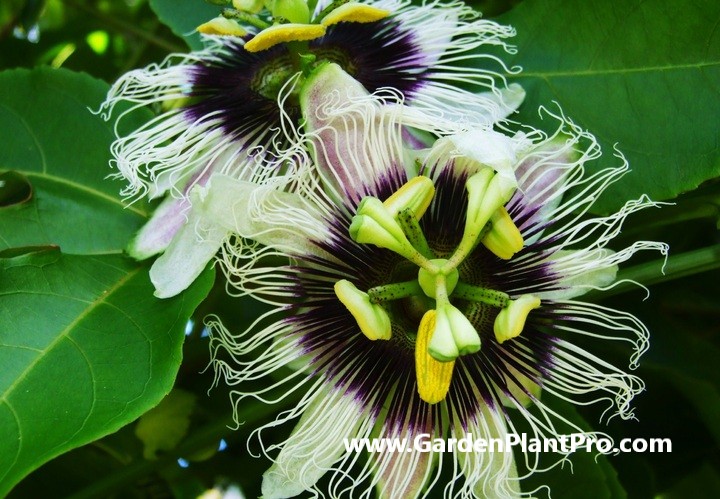
Common Diseases & How To Control Them
Passionfruit plants are vulnerable to several diseases, so it’s important to inspect them regularly for signs of infection. The most common diseases include Anthracnose, Fusarium wilt, and Passion fruit woodiness virus.
Anthracnose is a fungal disease that manifests as circular spots or blotches on the leaves and stems of the plant, often surrounded by a yellow halo. To control this disease, position the plant in a spot with ample air circulation and avoid overhead watering. It’s also important to remove infected plants, as well as any fallen leaves or fruit, to prevent further spread.
Fusarium wilt is a soil-borne fungus that causes wilting of plants and can lead to death if left untreated. It can be prevented by planting only virus-free plants and removing severely infected vines. Mulching around the plant can also help protect it from this disease.
The Passion fruit woodiness virus (PWV) is a serious virus that affects passionfruit vines and can cause leaf deformities as well as decreased fruit production. To control it, select only virus-free planting materials and eliminate mechanical transmission during pruning or training activities. It’s also important to clear away any infected leaves and fruit and dispose of them away from the plant.
Common Pests & How To Control Them
Like all plants, passionfruit can be susceptible to a variety of pests that can damage or even kill the plant if left unchecked. Here are some common pests that can affect passionfruit and how to control them:
Passionfruit Vine Hopper: These small, brown insects can cause significant damage to the plant by sucking the sap from the leaves, causing them to wilt and die. To control passionfruit vine hoppers, use an insecticidal soap or oil spray on the foliage every two weeks.
Scale Insects: These small, immobile insects can appear as bumps on the stem or leaves of the plant. They secrete a sticky substance called honeydew that can attract ants and promote the growth of black sooty mold. To control scale insects, use an insecticidal soap or oil spray, or remove them manually with a cotton swab dipped in alcohol.
Fruit Fly: Fruit flies can lay their eggs on the fruit of the passionfruit, causing it to rot and fall prematurely from the plant. To control fruit flies, use yellow sticky traps or cover the fruit with a fine mesh bag.
Spider Mites: These tiny, red or yellow mites can cause leaf discoloration, webbing, and leaf drop. To control spider mites, use a miticide spray, or wash the leaves with a strong stream of water to dislodge the mites.
Snails and Slugs: These slimy pests can chew on the leaves and stems of the plant, causing significant damage. To control snails and slugs, remove any debris or hiding places near the plant, and use a slug bait or trap.
In addition to these pests, passionfruit can also be susceptible to diseases such as fungal leaf spot and powdery mildew. To prevent the spread of disease, practice good garden hygiene by removing any fallen leaves or fruit, and avoid overhead watering. Regularly inspecting the plant for signs of pests or disease can help you catch any problems early on, making it easier to control and prevent further damage. To reduce the risk of fungal conditions, plant healthy vines every four or five years.
Companion Planting
Companion planting is a gardening technique that involves growing different plants together to benefit one another. When it comes to growing passionfruit, companion planting can help improve soil fertility, attract beneficial insects, and repel pests. Here are some companion plants that can be grown alongside passionfruit:
Basil: Basil is a great companion plant for passionfruit, as it can help repel pests such as fruit flies and whiteflies. It also attracts pollinators such as bees and butterflies, which can help improve fruit production.
Marigold: Marigold is another plant that can help repel pests, particularly nematodes in the soil. It also attracts beneficial insects such as ladybugs and lacewings, which can help control aphids and other pests.
Comfrey: Comfrey is a dynamic accumulator, which means it can help improve soil fertility by absorbing nutrients from deep in the soil and depositing them into its leaves. These leaves can then be used as a nutrient-rich mulch around the base of the passionfruit plant.
Nasturtium: Nasturtium is a great companion plant for passionfruit, as it can help repel pests such as aphids and whiteflies. It also attracts beneficial insects such as hoverflies and predatory wasps, which can help control pests.
Beans: Beans are a nitrogen-fixing plant, which means they can help improve soil fertility by converting atmospheric nitrogen into a form that can be used by plants. Planting beans near passionfruit can help provide the plant with a natural source of nitrogen.
In addition to these companion plants, other herbs such as rosemary and thyme can also be grown alongside passionfruit to repel pests and attract beneficial insects. When selecting companion plants, it’s important to consider their growing requirements, as well as their compatibility with the passionfruit plant. By practicing companion planting, you can create a healthy and thriving garden ecosystem that benefits all the plants in it.
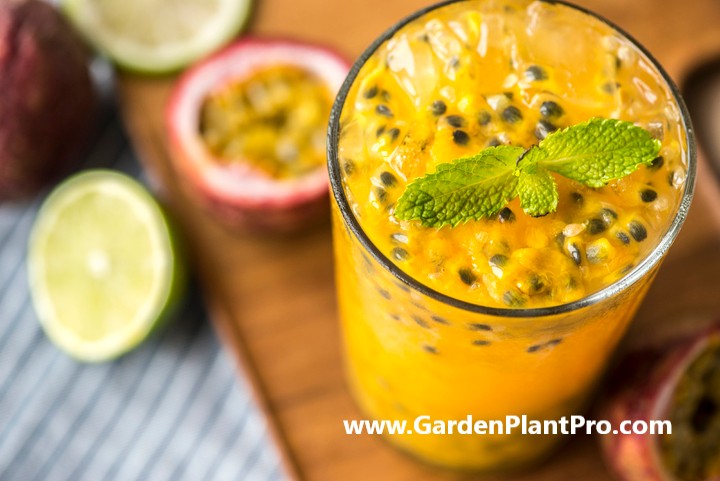
Using Your Harvest
Once the passion fruit has been harvested and stored, it is time to enjoy it. Passion fruit can be enjoyed fresh, juiced, and can even be used in a variety of recipes.
Fresh passion fruit can be eaten right out of the skin. Simply slice the fruit in half and scoop out the seeds with a spoon. The flesh has a sweet and tart flavor that is delicious on its own or added to other dishes.
Passion fruit can also be juiced for a delicious and refreshing beverage. To make passion fruit juice, simply blend the pulp with some water and strain it through a fine mesh sieve. You can also add sugar or honey to sweeten the juice if desired.
Passion fruit can also be used in many recipes such as smoothies, cocktails, sauces, desserts, ice cream, sorbet, cakes, and more. The flavor of passion fruit pairs well with tropical fruits like mangoes, pineapples, and bananas as well as with other tart flavors like lime and lemon.
The seeds of the passion fruit can also be used in recipes such as granola bars and energy bites. Simply blend the seeds with some honey or maple syrup and your favorite nuts or seeds for an easy snack packed with protein and healthy fats.
No matter how you choose to enjoy passion fruit, you’ll find that it is a delicious addition to your diet. With its unique flavor and numerous health benefits, it’s an excellent choice for adding sweetness to your meals while also providing essential vitamins and minerals to keep your body healthy.


